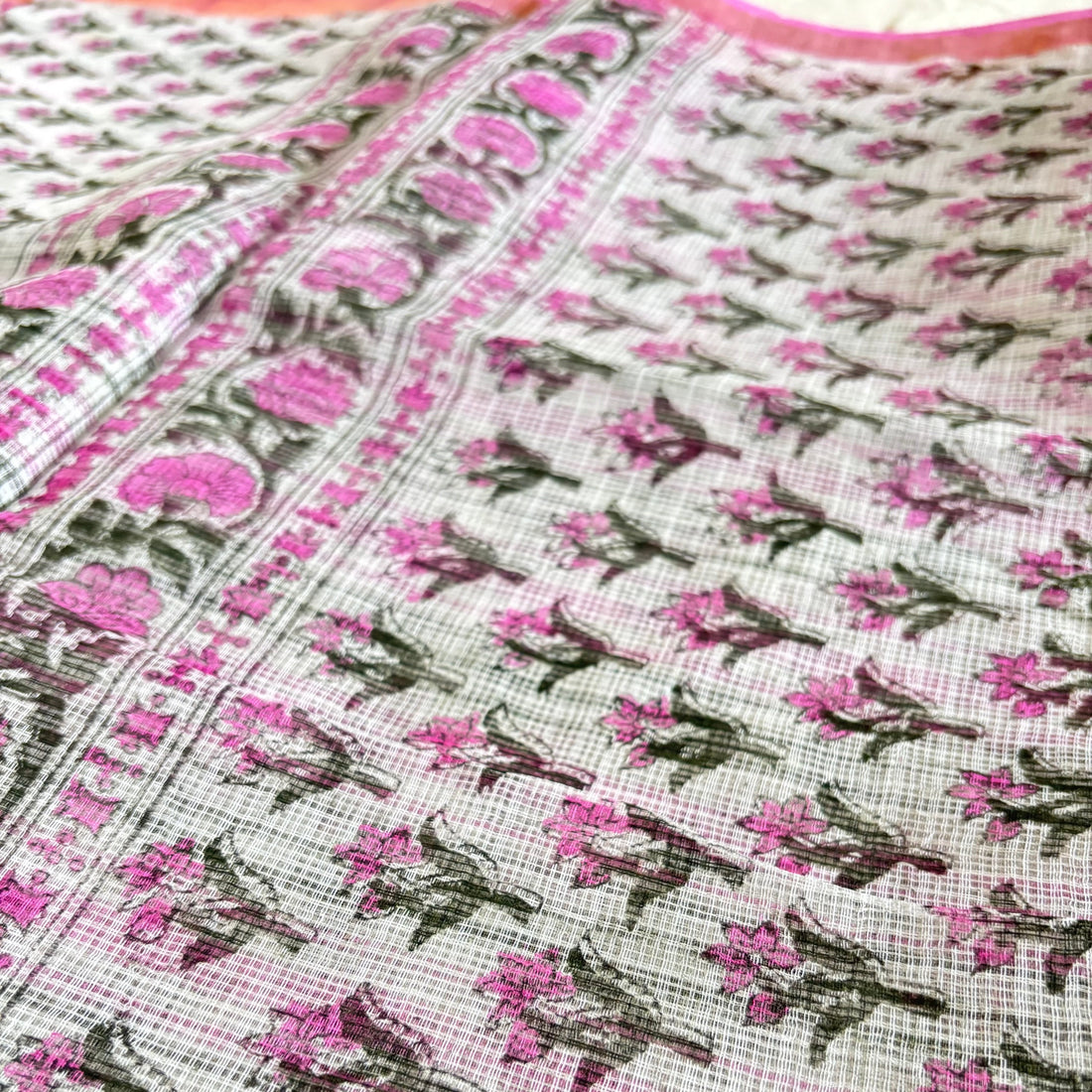
Threads of Legacy: Our Journey into the Heart of Kota Doria
There’s something deeply humbling about standing beside a pit loom, watching fine threads of silk and cotton come together into something diaphanous, beautiful, and timeless. We had always admired Kota Doria sarees for their lightness, their quiet grace—but it wasn’t until we visited Kaithoon, a small town near Kota in Rajasthan, that we truly understood the soul of this fabric.
This wasn’t just a textile. It was a legacy—one that lives through the hands of artisans, especially the women, who have kept it alive for generations.
Where It All Began
Kota Doria’s story stretches back centuries. Originally woven in Mysore, Karnataka, the art was brought to Rajasthan in the 18th century when Mughal General Rao Kishore Singh invited skilled weavers to migrate and settle in Kota. Over time, they adapted their craft to the desert climate and the cultural aesthetics of the region, creating what is now known as Kota Doria—‘Doria’ meaning ‘thread’ in Hindi.
The fabric quickly became prized for its unique structure: a delicate blend of cotton and silk, woven in a checkered pattern known as "khat". This distinctive feature gives the fabric its characteristic lightness and strength—a perfect balance for the harsh Indian summer.
The Loom Beneath the Floor
When we reached Kaithoon, the lanes buzzed not with traffic, but with the rhythmic, meditative clatter of looms hidden inside modest homes. It was here that we met a weaver family who invited us in with the kind of warmth that only exists in homes where generations live, work and create under the same roof.
Mehdi Hassan and his younger brother showed us around their workspace. Rolls of pastel and jewel-toned sarees sat neatly stacked along the walls. As we admired their work, we asked them a simple question: “How long has your family been weaving?”
They seemed amused by the question, making us wonder how many times must they have heard this question.
One finally said, “Kitni generations se kar re hain, yaad bhi nahi.”
(We've been weaving since so many generations, we’ve lost count.)
At that moment, we heard the gentle creak of a loom from another room. They led us inside the room where they had a pit loom atleast 5 feet in the ground and on the pit loom was an elderly man hunched over, hands moving with instinctual grace as he wove a radiant saffron saree. “Your father?” one of us asked. The younger one again amused by the assumption, said, “Nahi, dadaji hain.” (No, that’s our grandfather). Much to our astonishment.
Three generations of weavers under one roof—and the oldest was still creating.
Watching him weave was nothing short of spiritual. He worked quietly, the only sound being the wooden frame tapping into rhythm, silk and cotton threads dancing into checks of orange and gold. He didn’t need to look; his hands knew the path.
The Weave Itself
Kota Doria is woven using a balanced plain weave structure, where cotton gives the fabric strength and silk brings translucence and shine. The hallmark of the weave is the “khat”—tiny square patterns that make the fabric look like a delicate net but feel crisp and breathable.
The pit loom is crucial to this process, it is also one of the hardest looms to work with. The weaver sits with their legs in a shallow pit, working pedals with their feet while guiding threads with their hands. It's labor-intensive, but it allows incredible control and precision—every khat uniform, every thread intentional.
Women, Weaving, and Resilience
As we spent time in Kaithoon, it became clear that women were the real keepers of this heritage. As we crossed each house we heard the clatter of the pit loom with women working meticulously on the loom, everytime they'd catch us admiring their work, they’d acknowledge us with a smile.
We met with another weaver family who very proudly shared with us that every woman in their family from their mother to sisters and now their wives weave kota doria sarees. The sarees they create aren’t just garments; they are a means of livelihood for them and almost every other woman in living in Kaithoon. Each sari sold helps educate children, keep kitchens running, and sustain a community often left behind in the fast-paced world of fast fashion. Many of these women have never worn a Kota Doria saree themselves, yet they’ve sent thousands into wardrobes across the world.
Why Kota Doria Still Matters
In a world that celebrates speed, Kota Doria asks us to slow down.
It’s breathable and ideal for Indian summers, yes. But more importantly, it carries within its weave the warmth of a grandfather’s hands, the resilience of a weaver mother, the silence of tradition passed down by feel rather than formula.
For conscious consumers and lovers of handloom, owning a Kota Doria saree is more than a fashion choice—it’s a connection to India’s textile heritage and the people who keep it alive.
Final Threads
As we left Kaithoon, we took with us not just a few beautiful sarees, but the memory of that saffron fabric being woven by a man whose hands had guided threads longer than either of us has been alive. It reminded us why slow fashion matters— why stories, people, and traditions are as much a part of what we wear as the fabric itself.
And if you ever find yourself draping a Kota Doria saree, pause for a moment and run your fingers over the checkered khats. In that quiet geometry, you’ll feel more than threads. You’ll feel legacy.
